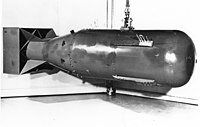
Photo from wikipedia
Winter frost has been considered the primary limiting factor in wheat production. Shimai 12 is an elite wheat cultivar grown in central and southern Hebei province of China, but sensitive… Click to show full abstract
Winter frost has been considered the primary limiting factor in wheat production. Shimai 12 is an elite wheat cultivar grown in central and southern Hebei province of China, but sensitive to winter frost. In this study, the winter frost tolerant cultivar Lunxuan 103 was bred by introducing the recessive allele vrn-D1 from winter wheat Shijiazhuang 8 (frost tolerance) into Shimai 12 using marker-assisted selection (MAS). Different from Shimai 12, Lunxuan 103 exhibited a winter growth habit with strong winter frost tolerance. In the Shimai 12 × Shijiazhuang 8 population, the winter progenies (vrn-D1vrn-D1) had significantly lower winter-killed seedling/tiller rates than spring progenies (Vrn-D1aVrn-D1a), and the consistent result was observed in an association population. Winter frost damage caused a significant decrease in grain yield and spike number/m2 in Shimai 12, but not in Lunxuan 103 and Shijiazhuang 8. The time-course expression analysis showed that the transcript accumulation levels of the cold-responsive genes were higher in Lunxuan 103 and Shijiazhuang 8 than in Shimai 12. Lunxuan 103 possessed the same alleles as its parents in the loci for plant height, vernalization, and photoperiod, except for the vernalization gene Vrn-D1. An analysis of genomic composition showed that the two parents contributed similar proportions of genetic compositions to Lunxuan 103. This study provides an example of the improvement of winter frost tolerance by introducing the recessive vernalization gene in bread wheat.
Journal Title: Frontiers in Plant Science
Year Published: 2022
Link to full text (if available)
Share on Social Media: Sign Up to like & get
recommendations!